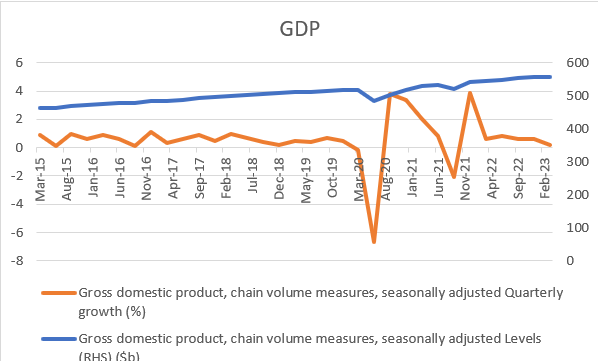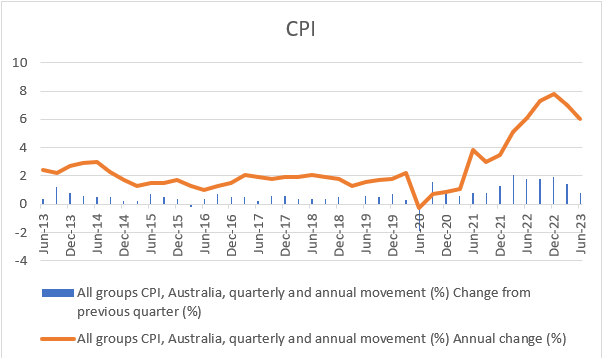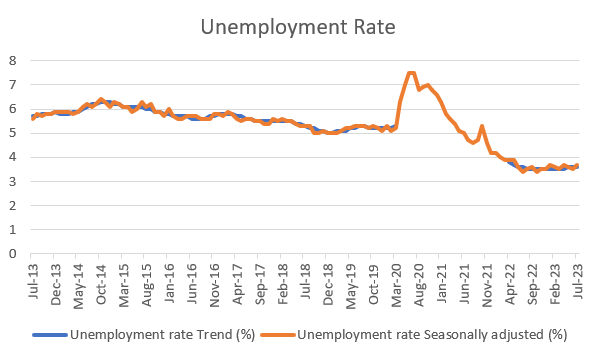Investigation 2
# Section 1
# Data
| Indicator | 2020 | 2021 | 2022 | 2023 |
|---|---|---|---|---|
| Unemployment | 13.5% | 8.5% | 6% | 6.25% |
| GDP Growth | 2% | -2% | 4% | 3% |
| Inflation | -0.2% | 2% | 6.1% | 6% |



# Report
The Australian economy is currently entering a contraction in the business trade cycle. GDP growth has started to decrease, with quarterly growth now at 0.2% for the March quarter which is down from the 0.6-0.8% growth from last year, which shows that economic growth is slowing down. As of July 2023, the seasonally adjusted unemployment rate is 3.7% which is higher than last year’s average of 3.5%. Inflation is starting to decrease from the high of 7.8% in December 2022, to 6% in June 2023. This shows that Australia’s economic growth is slowing down and that the economy is starting to enter the contraction stage of the business trade cycle, which has decreases economic growth and inflation, and increasing unemployment.
# Section 2
# Inflation
Inflation has been caused by supply shortages and high consumer demand. This includes the after-affects of covid and the Russian invasion of Ukraine. Consumer demand is high because during the pandemic many people didn’t spend as much due to restrictions so when the restrictions lifted, people had more money to spend which led to increased consumer demand. Also, the Russian invasion of Ukraine has led to grain and energy shortages which has increased the prices of many goods, increasing inflation. The high inflation in Australia has increased the price of goods and services significantly, which has increased the costs of living. The RBA has increased the cash rate significantly to combat the high inflation, which has increased interest rates. This also means that consumers have lower purchasing power as real wages have fallen.
# Unemployment
Covid had a severe impact on the Australian economy and labour market, as lockdowns and social distancing measures reduced economic activity and consumer spending. The unemployment rate rose from 5.1% in February 2020 to 7.5% in July 2021. The Australian Government introduced various economic support packages, such as the JobKeeper Payment wage subsidy scheme, to protect the economy and help workers stay connected with their employers. However, some sectors, such as tourism, hospitality, and arts, were more affected than others by the pandemic and experienced higher rates of job losses. The effects of this unemployment include lower income and living conditions. This decreases aggregate demand as less people are employed, so less people are earning money in the economy. This reduces economic growth as the economy isn’t being stimulated as much, and businesses aren’t getting as much money, so they decrease supply.
# References
- Natasha; Chan, C. (2020, December 10). Long-term Unemployment in Australia | Bulletin – December 2020. Reserve Bank of Australia; Reserve Bank of Australia. https://www.rba.gov.au/publications/bulletin/2020/dec/long-term-unemployment-in-australia.html
- Inflation. (2023). Github.io. https://pi-thagoras.github.io/the-chicken-pen/economics/Inflation.html
- Employment and unemployment. (2023, August 17). Australian Bureau of Statistics; Australian Bureau of Statistics. https://www.abs.gov.au/statistics/labour/employment-and-unemployment
- Eleanor. (2021, June 17). Underemployment in the Australian Labour Market | Bulletin – June 2021. Reserve Bank of Australia; Reserve Bank of Australia. https://www.rba.gov.au/publications/bulletin/2021/jun/underemployment-in-the-australian-labour-market.html
- Australia Unemployment Rate 1991-2023. (2023). Macrotrends.net. https://www.macrotrends.net/countries/AUS/australia/unemployment-rate
- Employment and unemployment - Australian Institute of Health and Welfare. (2021, September 16). Australian Institute of Health and Welfare. https://www.aihw.gov.au/reports/australias-welfare/employment-unemployment
- Reserve Bank of Australia. (2020). The Australian Economy and Financial Markets. https://www.rba.gov.au/chart-pack/pdf/chart-pack.pdf
- Bank. (2023). Australia’s Inflation Target | Explainer | Education. Reserve Bank of Australia. https://www.rba.gov.au/education/resources/explainers/australias-inflation-target.html
- Australian Bureau of Statistics. (2023, August 17). Australian Bureau of Statistics; Australian Bureau of Statistics. https://www.abs.gov.au/
- Australian National Accounts: National Income, Expenditure and Product, March 2023. (2023, June 7). Australian Bureau of Statistics; Australian Bureau of Statistics. https://www.abs.gov.au/statistics/economy/national-accounts/australian-national-accounts-national-income-expenditure-and-product/mar-2023#economic-overview
- Astbury, H. (2023). Statistics on the Australian economy. Savings.com.au. https://www.savings.com.au/news/australian-economy-statistics